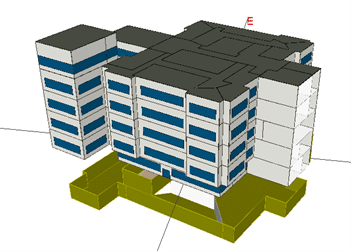Increasingly clients seeking to optimize costs and reduce environmental footprints are turning to building and portfolio electrification to avoid direct emissions from on-site combustion for building heat and hot water. While that nut may be harder to crack than it appears, the aspiration is vital to avoid the worst impacts of climate change.
California’s state energy code, Title 24, just went under a triennial revision. The 2022 15-day “red-line” version of the code is available on the CEC’s website. As I work with clients to identify a plan for eliminating natural gas heating from their building portfolios, I always frame recommendations against what they’ll have to do anyway. Utility Dive praised their improvements for building electrification, but their coverage was a tad light on the details. Details are where I thrive, so let’s dive in together.
Brief Overview of Title 24
Title 24 is California’s state-wide building code. Title 24-Part 6 is the state-wide building energy code. For brevity, I’ll use Title 24 throughout this article when referring specifically to part 6. The code is revisited every three years. The original goal of the energy code was to minimize energy use in buildings by minimizing waste and establishing minimum operating efficiencies. With the 2019 Energy Code, the California Energy Commission established rooftop solar requirements for new residential construction, meeting their goal first stated in 2008 for net zero energy user. The CEC’s eye is now on the 2030 goal for new commercial construction.
Title 24 and Heating Requirements
Title 24 is broken into sections, each describing a subset of requirements related to a specific building discipline, process, or practice. For all-electric space heating, the following sections contain key requirements:
- §110.2 Mandatory Requirements for Space Conditioning Equipment
- §120.2 Required Controls for Space-Conditioning Systems
- §140.4 Prescriptive Requirements for Space Conditioning Systems
- §141.0 Additions, Alterations, and Repairs of Existing Non-Residential Buildings
Note, there are lots of other code sections – the sections above are relevant to space heating.
§110.2 Mandatory Requirements for Space Conditioning Equipment
In §110.2, code defines the requirements related to equipment made available inside the state for installation in new and existing buildings. These requirements include nominal full- and part-load efficiencies, basic controls, and other miscellaneous requirements related to the manufacture of these systems. While the design requirements of this chapter are light and mostly directed towards manufacturers, there are a few things that stand out with respect to electric heating systems:
§110.2(b) Heat pumps with electric resistance booster heaters must have controls that prioritize the heat pump over the resistance coil, making sure that the heat pump loads up first before the supplementary heat begins to cycle. The electric resistance coil may cycle on when the heat pump is in defrost mode (purging any accumulated ice on the outdoor coil) or during transient events (system startup or in response to change in temperature setpoint). These two exceptions attempt to address some specific design considerations necessary to have a responsive comfortable space heating system using a heat pump and are retained from Title 24-2019 unchanged.
§120.2 Required Controls for Space-Conditioning Systems
Section 120.2 outlines control requirements for all space conditioning systems. These requirements are generally geared toward the system designer, who is responsible for ensuring that the building-specific layout of the controls meet these requirements. The requirements in this section of code are many and not all entirely related to space heating. The interesting ones for electric space heating include:
§120.2 (b) 1: Zone level controls must be able to setback to ≤ 55°F. Smart use of setback controls can better allow our buildings to curtail overnight use and minimize warm-up times – particularly during the cold snaps we get in the winter. (Note, I’m using the Californian definition of a cold snap – not those icey cold snaps you get in the rest of the country – those would be apocalyptic cold snaps here in the Golden State). Using setback setpoints can help air handlers and space heaters start later in the morning and prevent building operators from scheduling obscenely early morning starts to address the one or two weeks in the winter when that is necessary. This requirement was in the Title 24-2019 and remains unchanged.
§120.2 (d): Heat pumps with electric resistance booster heaters must have controls that prioritize the heat pump over the resistance coil. The CEC is serious guys. Not only must manufacturers provide this control capability, as spelled out in §110, the designer must include it in their design.
§120.2 (k): Optimum Start/Stop Controls. Systems with direct digital controls down to the zone must use an optimum start stop sequence. This should be a slam dunk (or no-brainer, but I’ve been told that is a little too harsh, so we stick to basketball allusions). When we’re using heat pumps, we’re using a lot of juice in the mornings before the sun comes up, when our emissions per kWh of electricity are the highest. Anything we can do to curtail energy during these hours will be boon for our site-specific CO2 emissions.
§140.4 Prescriptive Requirements for Space Conditioning Systems
The prescriptive requirements for space conditioning systems is where most of the electrified heating system changes come to life!
§140.4 (a) 2: Title 24 mandates heat pumps for single-zone systems with a cooling capacity < 20 tons in most of the state (based on size of the hardware and climate zone). These requirements are all new for 2022!
- Office, Financial Institutions, Libraries, Retail, and Grocery Stores
- North Cost & Mountainous California (BCZ 1 and 16):
- Units < 65 kBtu/hr; air conditioner with furnace
- Units ≥ 65 kBtu/hr; dual fuel heat pump
- Rest of the state (BCZ 2 through 15)
- Heat pumps required
- North Cost & Mountainous California (BCZ 1 and 16):
- School Buildings
- North Cost & Mountainous California (BCZ 1 and 16):
- Dual fuel heat pump required
- Rest of the state (BCZ 2 through 15)
- Heat pumps required
- North Cost & Mountainous California (BCZ 1 and 16):
- Offices inside a warehouse
- Statewide, heat pumps required
§140.4 (g) Title 24 retains its broad prohibition of electric resistance heating. A 100% electric resistance space heating system is still prohibited, as it was in Title 24-2019. The laundry list of exemptions are still retained:
- When the ERH system supplements a heating system for which 60% of the annual energy is provided by site-solar or recovered energy
- When used as supplementary heating to a heat pump that supplies at least 75% of the design load.
- When the ERH system capacity is less than 10% of the total heating capacity for building
- When the total building capacity of ERH (not covered by #2) is less than 3 kW
- When the ERH serves all the following:
- A building that is not hotel/motel
- A whole building
- Less than 5,000 ft²
- Has no mechanical cooling
- Has no gas service
- An emergency backup to gas heating equipment.
§140.4 (k) 8: Title 24 -2022 adds a new set of requirements for large space-heating hot water systems. In climate zones 1,2,3,4,5,6,9,10,11,12,13,14,16 (excluding coastal San Diego, Orange, Los Angeles counties and most of Imperial county) if the total hot water loop is ≥ 1,000 kBtu and ≤ 10,000 kBtu, a designer must specify following:
- A 90% efficient boiler
- Coils/heat exchangers designed to return 120°F hot water
- A minimum design system flow ≤ 20% of the max design flow
The following exclusions are pretty minor:
- Systems with ≥25% of the heating energy comes from on-site renewables/recovered energy
- Individual dwelling heating boilers
- Where ≥50% of the load comes from perimeter convective and/or radiative panels
- Individual boilers less than 300 kBtu are excluded from the load total
Together these requirements minimize natural gas consumption by essentially mandating condensing boilers in new construction. Furthermore, they support the eventual replacement of these boilers with all-electric heat pump water heaters eventually. The system effects that generally make condensing boilers efficient also allow heat pump water heaters to achieve high efficiencies.
What about performance compliance?
California allows building designers to comply with Title 24 using one of two approaches: performance compliance and prescriptive compliance.

The performance compliance path requires a building energy model to prove that a design will be below the design energy budget. While the designer must still include mandatory and required chapter requirements, the established energy budget gives the designer a lot of freedom – particularly when photovoltaics and battery storage are factored in. This flexibility comes at a cost since quality energy models don’t come cheap.
Prescriptive compliance usually involves the lowest overall design budget, since the design must only factor in all the individual requirements contained in Title 24 mandatory, required, and prescriptive chapters. The prescriptive approach can be limiting – particularly if you’re doing something novel or wish to be particularly efficient in one building application to afford yourself extra power in another application (e.g. designing a particularly efficient building envelope and in exchange specifying less efficient space conditioning hardware).
Generally, when I work with customers looking for electrification, I like to plan around prescriptive code compliance, which is the most well suited for existing buildings, since we only need to be concerned specifically with the hardware and system we’re modifying. Performance compliance is still an option; although I wouldn’t expect the results to be terrible accurate (even if they meet Title 24 allowances).
§141.0 Additions, Alterations, and Repairs of Existing Non-Residential Buildings
§141.0 (b) 2 C: New or replacement space-conditioning systems or components have to meet the requirements discussed in §140.4, with a few exceptions – none of which apply directly to space heating systems. That means replacement single-zone units, boilers, coils, and other heating heat exchangers must meet the requirements outlines above – with no particular carve-outs for existing buildings. This could have some pretty significant impacts on many replace-on-burn out projects.
What Does This Mean for Electrification in California?
On the whole, I think the hype is well justified. Title 24-2022 makes good on their goal for commercial building electrification with some common-sense requirements for building electrification. Existing building electrification will remain a hurdle to navigate and plan around. Specifically, the requirement that most failed single-zone package units in existing buildings need to include heat pumps of one sort or another could create structural headaches (heat pumps are generally heavier than a conventional DX-gas pack) and electrical infrastructure (heat pump heating systems – particularly with electric resistance supplemental heating coils – could tax the existing conductor sizing, panel capacity, and ultimately the electrical service to the site).
If your building type isn’t affected by these requirements yes, consider this a preview of what’s to come. As evidence accumulates that these systems are practical and heat pump technology improves, these requirements will come to additional building types and applications.
If you’re looking to electrify a building or a portfolio of building and need a little help, contact us anytime.


